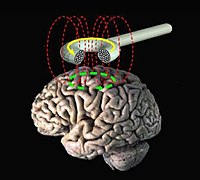
Time course of changes in corticospinal excitability induced by motor imagery during action observation combined with peripheral nerve electrical stimulation
Sign Up to like & getrecommendations! Published in 2018 at "Experimental Brain Research"
DOI: 10.1007/s00221-018-5454-5
Abstract: While previous studies assessed corticospinal excitability changes during and after motor imagery (MI) or action observation (AO) combined with peripheral nerve electrical stimulation (ES), we examined, for the first time, the time course of corticospinal… read more here.
Keywords: imagery; stimulation; corticospinal excitability; time ... See more keywords

Motor and spatial representations of action: corticospinal excitability in M1 after training with a bimanual skill
Sign Up to like & getrecommendations! Published in 2020 at "Experimental Brain Research"
DOI: 10.1007/s00221-020-05795-x
Abstract: The purpose of the study was twofold: (1) determine if different time delays (30 min or 6 h) between training and a post-training test with a rhythmic bimanual pattern (90° relative phase) would be associated with different… read more here.
Keywords: pattern; corticospinal excitability; training; motor ... See more keywords

Adaptations in corticospinal excitability and inhibition are not spatially confined to the agonist muscle following strength training
Sign Up to like & getrecommendations! Published in 2017 at "European Journal of Applied Physiology"
DOI: 10.1007/s00421-017-3624-y
Abstract: PurposeWe used transcranial magnetic stimulation (TMS) to determine the corticospinal responses from an agonist and synergist muscle following strength training of the right elbow flexors.MethodsMotor-evoked potentials were recorded from the biceps brachii and flexor carpi… read more here.
Keywords: strength; following strength; muscle; corticospinal excitability ... See more keywords

Effects of high-altitude exposure on supraspinal fatigue and corticospinal excitability and inhibition
Sign Up to like & getrecommendations! Published in 2017 at "European Journal of Applied Physiology"
DOI: 10.1007/s00421-017-3669-y
Abstract: PurposeWhile acute hypoxic exposure enhances exercise-induced central fatigue and can alter corticospinal excitability and inhibition, the effect of prolonged hypoxic exposure on these parameters remains to be clarified. We hypothesized that 5 days of altitude exposure… read more here.
Keywords: corticospinal excitability; supraspinal fatigue; fatigue; excitability inhibition ... See more keywords

Increased auditory stimulus intensity results in an earlier and faster rise in corticospinal excitability
Sign Up to like & getrecommendations! Published in 2020 at "Brain Research"
DOI: 10.1016/j.brainres.2019.146559
Abstract: Increasing the intensity of auditory stimuli has been shown to produce faster simple reaction times (RTs). Typical explanations for this effect involve earlier detection of the more intense stimulus; however, these explanations fail to consider… read more here.
Keywords: corticospinal excitability; auditory stimulus; stimulus intensity; intensity ... See more keywords

Towards assessing corticospinal excitability bilaterally: Validation of a double-coil TMS method
Sign Up to like & getrecommendations! Published in 2018 at "Journal of Neuroscience Methods"
DOI: 10.1016/j.jneumeth.2017.09.016
Abstract: BACKGROUND For several decades, Transcranial magnetic stimulation (TMS) has been used to monitor corticospinal excitability (CSE) changes in various contexts. Habitually, single-coil TMS is applied over one primary motor cortex (M1), eliciting motor-evoked potentials (MEPs)… read more here.
Keywords: corticospinal excitability; method; double coil; tms ... See more keywords

Randomising stimulus intensity improves the variability and reliability of the assessment of corticospinal excitability
Sign Up to like & getrecommendations! Published in 2020 at "Journal of Neuroscience Methods"
DOI: 10.1016/j.jneumeth.2020.108813
Abstract: BACKGROUND Advances in the control of transcranial magnetic stimulation (TMS) have enabled greater randomisation of stimulus intensity. It is unclear if such randomisation improves assessments of corticospinal excitability. NEW METHOD We recorded the amplitude of… read more here.
Keywords: corticospinal excitability; stimulus intensity; variability; tms ... See more keywords

Corticospinal excitability and psychiatric symptoms in multiple sclerosis
Sign Up to like & getrecommendations! Published in 2018 at "Neurophysiologie Clinique"
DOI: 10.1016/j.neucli.2018.05.004
Abstract: Objectives Patients with multiple sclerosis (PwMS) frequently suffer from psychiatric symptoms [2] . Anxiety and depression are among the most reported ones and could drastically affect patients’ quality of life [2] . Understanding the underlying… read more here.
Keywords: depression; anxiety; corticospinal excitability; anxiety depression ... See more keywords

Modulation of quadriceps corticospinal excitability by femoral nerve stimulation
Sign Up to like & getrecommendations! Published in 2017 at "Neuroscience Letters"
DOI: 10.1016/j.neulet.2016.11.033
Abstract: INTRODUCTION We explored the conditioning effect of a percutaneous electrical pulse of the femoral nerve on cortical motor evoked responses in the rectus femoris muscle. METHODS Corticospinal excitability of rectus femoris muscle was measured in… read more here.
Keywords: stimulus; corticospinal excitability; transcranial magnetic; femoral nerve ... See more keywords

Time course changes in corticospinal excitability during repetitive peripheral magnetic stimulation combined with motor imagery
Sign Up to like & getrecommendations! Published in 2022 at "Neuroscience Letters"
DOI: 10.1016/j.neulet.2021.136427
Abstract: Repetitive peripheral magnetic stimulation (rPMS) induces proprioceptive afferents and facilitates corticospinal excitability. Short-term sessions of rPMS combined with motor imagery (MI) enhance corticospinal excitability more than rPMS alone. However, it is not clear how long… read more here.
Keywords: rpms; repetitive peripheral; motor; rpms combined ... See more keywords

Age-related changes in corticospinal excitability and intracortical inhibition after upper extremity motor learning: a systematic review and meta-analysis
Sign Up to like & getrecommendations! Published in 2017 at "Neurobiology of Aging"
DOI: 10.1016/j.neurobiolaging.2017.03.024
Abstract: It is unclear how old age affects the neuronal mechanisms of motor learning. We reviewed the neuronal mechanisms of how healthy old and young adults acquire motor skills as assessed with transcranial magnetic stimulation. Quantitative… read more here.
Keywords: age; corticospinal excitability; motor learning; motor ... See more keywords